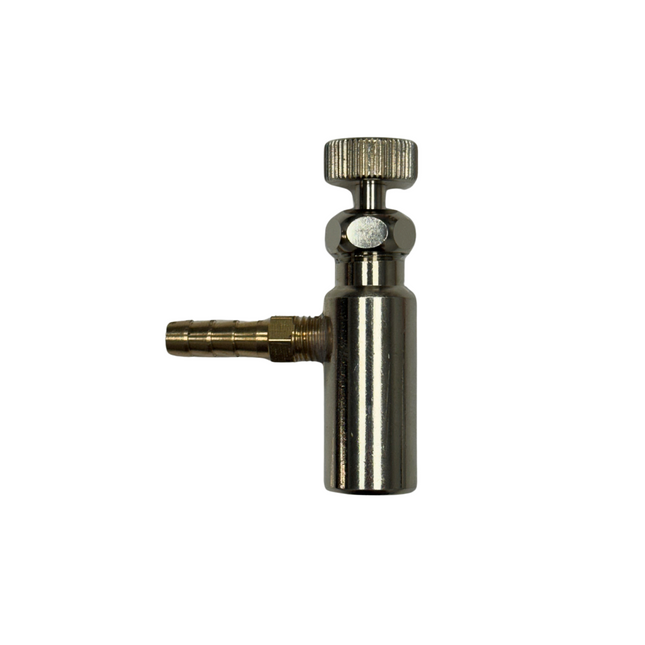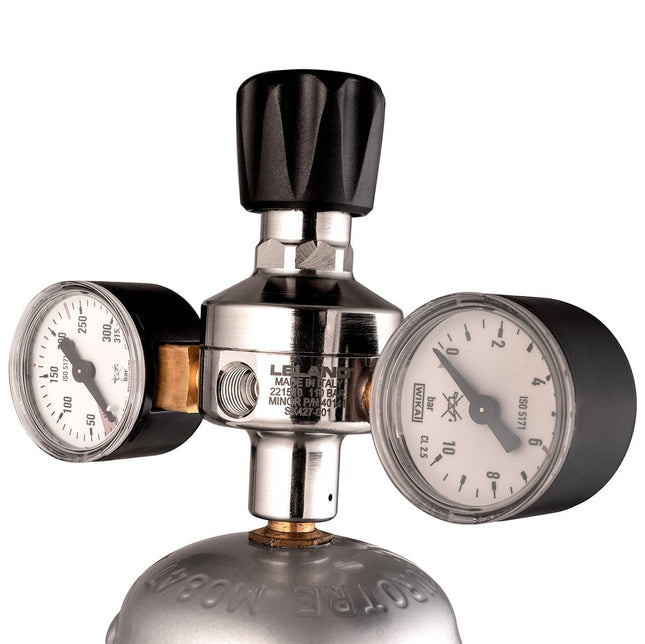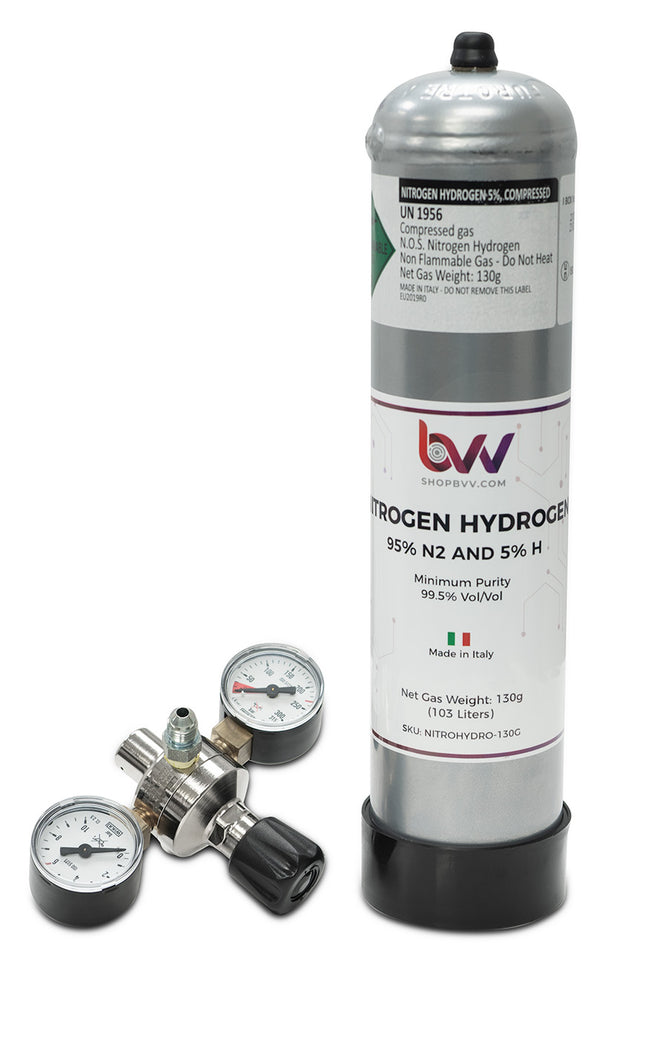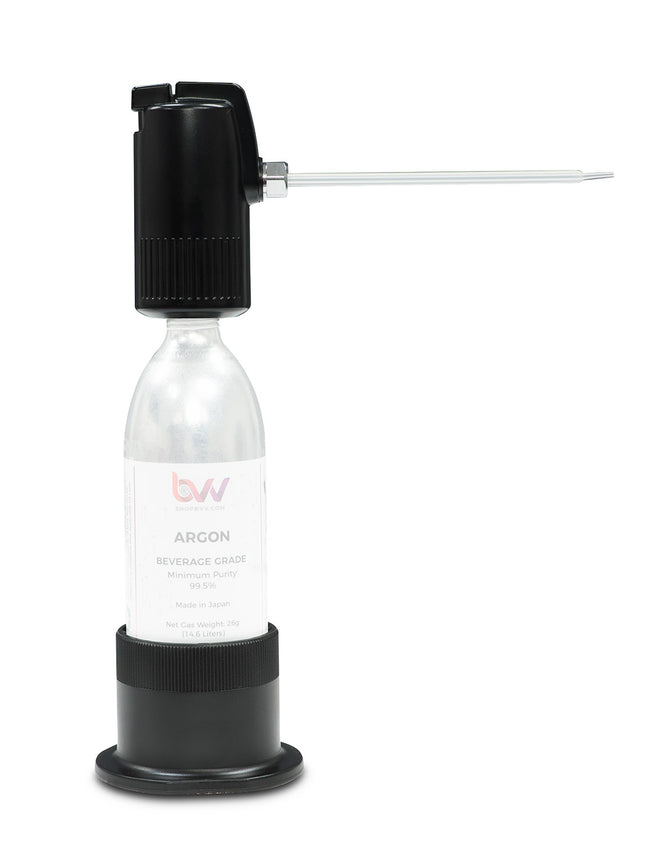Nitrogen
-


Nitrogen Tank for Extraction 99.5% Pure
Nitrogen Beverage Grade 99.5% Pure Made in Italy This modest but mighty nitrogen tank is a great to pair with any 2lb or smaller extraction system. For those customers that need nitrogen to push their solvent through color remediation columns (CRC) or for those super cold dewax extractions that need the extra push to get the remaining solvent out of the cold columns. This tank will produce a continuous ~66.5 Seconds of Nitrogen @ 80PSI. Directions: (*Hose not Included with regulator) Connect a stainless steel braided 1/4" JIC hose (or vacuum hose BVV-HVAC) to your extractor, placed at the valve where you need your extra pressure push. Using the needle valve you can open the regulator and the nitrogen will flow. Pressurize 15-30PSI. *Note Nitrogen Tank Pressure is 1580 PSI *At end of use, completely empty the tank for recycling. Tank Volume of Nitrogen Coverage Product Sku: 130g / 103 Liters / 3.67 Cubic Feet See Use Chart Below... NITROGEN-130G Regulator/Dispenser Details (not included with tank only purchase) Nitrogen Regulator - Adjustable via. needle valve, regulated to 80 PSI. Made in Italy. Thread: M11x1 (tank connection). Output: 1/4" JIC to connect to any of our 1/4" extractor hoses or vacuum hoses. Gauges read in BAR. M11 Valve Dispenser Kit - Includes adjustable pushpin style valve dispenser. Output: 1/4" JIC Flare, NO GAUGE. Connects to any 1/4" JIC Hose. How long will it last?: A 1lb column of biomass (3"x24") is equal to ~2.7 liters empty. That's about 38 column volumes. Assuming you only used 4 column volumes per extraction you would get ~10 extractions from one tank. Column Size Column Volume # Runs/Tank 1.5x12 (70g biomass column) 0.34 Liters ~75 2x12 (120g biomass column) 0.6 Liters ~54 3x24 (1lb biomass column) 2.7 Liters ~12 4x24 (2lb biomass column) 4.9 Liters ~6 *Use calculated @ 4 column volumes per run What Is Nitrogen Gas? Nitrogen gas is a chemical element and a diatomic molecule with the chemical formula N2. It is a colorless, odorless, and tasteless gas that makes up about 78% of Earth's atmosphere by volume. Nitrogen gas is an essential component of the air we breathe and plays a crucial role in various natural processes and industrial applications. In its gaseous form, nitrogen is composed of two nitrogen atoms tightly bonded together by a strong triple bond. Due to its stable molecular structure, nitrogen gas is relatively inert and does not readily react with other substances under normal conditions. What Is Nitrogen Gas Used For? Nitrogen gas has a wide range of applications across various industries and scientific fields due to its inert nature, abundance, and unique properties. Some of the key uses of nitrogen gas include: Food Preservation: Nitrogen gas is used to create controlled atmospheres in food packaging to extend the shelf life of perishable products. It helps prevent the growth of spoilage microorganisms and maintains the freshness of packaged foods. Laboratory Applications: Nitrogen gas is used in laboratories as a carrier gas for chromatography, as a purge gas to remove oxygen and moisture from sensitive reactions, and for preserving and storing samples. Welding and Metalworking: Nitrogen gas is employed as a shield gas during welding and metalworking processes to prevent oxidation and maintain the integrity of metal surfaces. Electronics Manufacturing: In electronics manufacturing, nitrogen gas is used to create inert environments that prevent oxidation and improve the quality of soldering and component assembly. Cryogenic Applications: Nitrogen gas, when cooled to extremely low temperatures, becomes liquid nitrogen. It is used in cryopreservation of biological samples, freezing and storing biological materials, and in various cryogenic cooling applications. Fire Suppression: Nitrogen gas is utilized as a fire suppressant in certain situations to reduce the concentration of oxygen, effectively suppressing fires and preventing explosions. Oil and Gas Industry: In the oil and gas industry, nitrogen gas is used for pressure testing pipelines, purging equipment, and enhancing oil recovery. Medical and Healthcare: Nitrogen gas is used in medical applications, such as cryotherapy for skin treatments, freezing of warts and lesions, and providing a dry environment for sensitive medical instruments. tAerospace and Aviation: Nitrogen gas is used to pressurize aircraft tires and hydraulic systems, preventing moisture and oxidation-related issues. Fertilizer Production: Nitrogen gas is a key component in the production of ammonia-based fertilizers, which are essential for promoting plant growth in agriculture. Diving Industry: In underwater diving, nitrogen gas is used in breathing gases such as air and nitrox. Pneumatic Systems: Nitrogen gas is used in pneumatic systems for inflating tires, powering tools, and operating machinery. Food and Beverage Industry: Nitrogen gas is used to dispense draft beer, wine, coffee, and other beverages, creating a foamy head and enhancing the presentation. How Can I Pressure Test My Extractor With Nitrogen? Pressure testing your extractor with nitrogen involves using nitrogen gas to check for leaks, verify the integrity of the equipment, and ensure its safety before performing actual extraction processes. Here's a step-by-step guide on how to pressure test your extractor using nitrogen gas: Materials Needed: Nitrogen gas cylinder with appropriate regulator Pressure gauge PTFE tape (thread seal tape) Bubble solution or soapy water Safety goggles and gloves Wrench or spanner Steps: Preparation: Ensure that the extractor is clean and free from any residual materials. Check all fittings, connections, valves, and joints for signs of damage, wear, or corrosion. Replace any damaged components. Make sure the extractor is properly assembled and closed, including any access ports or lids. Safety Precautions: Wear appropriate safety goggles and gloves to protect your eyes and hands. Work in a well-ventilated area to prevent the buildup of nitrogen gas. Regulator Setup: Attach the nitrogen gas cylinder to the regulator and secure it tightly using a wrench. Set the desired pressure on the regulator according to the recommended pressure for your extractor and testing requirements. Sealing Threads: Apply PTFE tape to the threads of the fittings and connections. This helps create a better seal and prevents leaks. Connect Nitrogen Gas: Connect the regulator outlet to the appropriate inlet or access port on the extractor using a compatible hose or tubing. Pressure Testing: Slowly open the nitrogen gas cylinder valve to allow gas to flow into the extractor. Monitor the pressure gauge and allow the pressure to build up to the desired test pressure. Once the desired pressure is reached, close the cylinder valve to stop the flow of nitrogen gas. Leak Detection: If pressure is not maintained apply a bubble solution or soapy water to all the fittings, joints, and connections. Inspect the extractor for any bubbles forming, indicating potential leaks. Pay close attention to areas where bubbles appear, and tighten or adjust fittings after depressurizing the system as needed to eliminate leaks. Release Pressure: Slowly release the pressure from the extractor by gradually opening the cylinder valve. Once the pressure is completely released, disconnect the nitrogen gas source. Final Inspection: Reapply the bubble solution or soapy water to the connections that were adjusted. Verify that no bubbles form, indicating that leaks have been successfully resolved. Documentation: Keep a record of the pressure test results, including the test pressure and any adjustments made. Repeat if Necessary: If any leaks were detected and resolved, repeat the pressure test to ensure all leaks have been eliminated. Pressure testing your extractor with nitrogen gas helps ensure the safety and integrity of the equipment, minimizing the risk of leaks during actual extraction processes. Always follow proper safety guidelines and manufacturer recommendations when working with nitrogen gas and pressure testing equipment. How Do I Perform A Nitrogen Assisted Extraction? Using nitrogen to inject butane into a closed-loop extraction system requires careful consideration and adherence to safety protocols. Nitrogen gas can be used to pressure test the extraction system, assist in transferring butane throughout the system, and assist in the process of adsorbent filtration/color remediation. Here's a step-by-step guide on how to use nitrogen to inject butane into your closed-loop extraction setup: Materials Needed: Closed-loop extraction system with Pressure Relief Valve Nitrogen gas cylinder with appropriate regulator Pressure gauge Nitrogen-compatible hose or tubing Butane tank Butane-compatible hose or tubing Safety goggles and gloves Wrench or spanner Steps: Safety Precautions: Wear appropriate safety goggles and gloves to protect your eyes and hands. Work in a C1D1 environment to prevent the buildup of flammable gases. Preparation: Ensure that the closed-loop extraction system is clean, properly assembled, and free from any residual materials. Regulator Setup: Attach the nitrogen gas cylinder to the regulator and secure it tightly using a wrench. Set the desired pressure on the regulator based on the recommended pressure for your closed-loop system and extraction process We recommend utilizing 25-50 PSI to perform solvent transfer throughout the system. Nitrogen Line Connection: Connect the regulator outlet to the nitrogen-compatible hose or tubing. Connect the other end of the hose to the vapor port or accessory port to the recovery cylinder of your closed-loop system. Butane Line Connection: Connect the recovery cylinder to the closed-loop system using a butane-compatible hose or tubing. Ensure that the recovery cylinder is securely connected to the system, properly sealed, and grounded. Pressurizing the System: Slowly open the nitrogen gas cylinder valve to allow nitrogen gas to flow into pressurize the recovery cylinder. Monitor the pressure gauge and pressurize the recovery cylinder to the desired pressure for injecting butane. Nitrogen gas is used to create pressure that forces the butane into the system. Injecting Butane: Open the valve on the recovery tank to allow the butane to flow into the material column of the closed-loop system. The pressurized nitrogen gas assists in transferring the butane through the system and into the collection base of the system. Monitoring and Safety: Carefully monitor the pressure levels on both the nitrogen gas cylinder and the recovery cylinder. Venting: Once the injection and extraction processes are complete, close the valves on both the nitrogen gas cylinder and the recovery tank. Prior to applying heat to your collection base and starting your solvent recovery procedure first slowly vent the nitrogen from the collection base directly into the ventilation system of your C1D1 Booth. Monitor the pressure gauge and sight glass of the collection base closely. Slowly and incrementally vent the nitrogen from the system until the solution begins to boil this is an indication that the nitrogen filling the headspace of the collection base has been removed and the butane is filling the remaining headspace. Additionally, if the pressure starts to increase after an incremental venting procedure that is a good indication that the nitrogen has been released from the system and the butane is building pressure within the system. If the tank PSI remains the same after a venting procedure then nitrogen is most likely still within the system. Recovery: Once the nitrogen has been successfully removed from the collection base proceed to vent the nitrogen from the empty recovery cylinder and pull the recovery cylinder and the associated lines under vacuum. With the nitrogen now removed from both the collection base and recovery cylinder you can now proceed with your recovery procedure Disconnect the nitrogen gas line and the butane line from the closed-loop system. Properly store the nitrogen gas cylinder and the recovery tank according to safety guidelines. Using nitrogen to inject butane into a closed-loop extraction system requires a solid understanding of the equipment, processes, and safety procedures involved. Always refer to your closed-loop system's manufacturer guidelines and follow best practices for safe operation. How Much Nitrogen Pressure Do I Need For Adsorbent Filtration/ Color Remediation? The nitrogen pressure required for adsorbent filtration and color remediation can vary depending on the specific equipment, setup, and the type of media you are using. It's essential to follow the manufacturer's recommendations for your particular closed-loop extraction system and adsorbent filtration equipment. In general, nitrogen gas can be used to apply pressure to assist in pushing the solvent through the adsorbent media, enhancing the filtration and color remediation process. The pressure you need may vary based on factors such as the viscosity of the solvent, the flow rate, the type of adsorbent media, and the desired results. It's recommended to start with a moderate nitrogen pressure and gradually increase it while monitoring the flow rate and effectiveness of the process. Generally, pressures in the range of 20 to 50 psi (pounds per square inch) are commonly used for adsorbent filtration and color remediation. However, this pressure range can be adjusted based on your specific equipment and requirements. Keep in mind that using too high of a pressure can potentially cause channeling, uneven flow, and limited retention through the adsorbent media, affecting the quality of the filtration process. It's essential to strike a balance between achieving effective filtration and avoiding excessive pressure that could lead to inefficient results or potential safety risks. It's best to perform small-scale tests before scaling up to ensure optimal results and start off slowly when using nitrogen pressure for adsorbent filtration and color remediation. Chemical Formula: N2 Molecular Weight: 28.014 g/mol CAS Registry Number: 7727-37-9 Appearance Colorless Odor: Odorless Density 0.072 lb/ft3 Boiling Point: -196C (-320.8F) Solubility in water: N/A GHS Pictograms: GHS Signal Word: Warning GHS Hazard Statements: H280, H281 GHS Precautionary Statements P282, P336+P317, P403, and P410+P403 UN Identification Number: 1066 Proper Shipping Name: Nitrogen, Compressed Transport Hazard Class: 2.2 Packing Group: None DOT Placard: Nitrogen Safety Data Sheet (SDS)
$56.91 - $219.30
-


M11x1.0 Valve Dispenser for Compressed Gas
Valve Dispenser Thread Size M11x1.0 Pushpin Valve Type Our regulators are threaded and designed to fit our compressed gas tanks. Nitrogen, Argon, Helium, Nitrogen & Hydrogen Blend, and Best Whip Nitrous Oxide cylinders. This dispenser is simply a valve that will install onto the tank and will allow you to slowly or rapidly dispense the gas. The valve has a center pin, when the knob is turned clockwise it will depress the pin in the tank slowly to dispense the gas. You can even remove the valve dispenser when not in use. Compatible with CO2, Nitrogen, Argon, Nitrogen-Hydrogen mix, Nitrous Oxide and Helium. *The valve dispenser in this listing does not come with hoses, or cylinders.
$99.93
-


M11x1.0 Regulator for Compressed Gas
Regulator for Compressed Gas Bare Regulator No output Fitting This regulator is designed to fit our compressed gas tanks. Nitrogen, Argon, Helium, Nitrogen & Hydrogen Blend, and Best Whip Nitrous Oxide cylinders. Adjustment knob Is turned on to start gas flow and set desired pressure. Turn clockwise to engages the pin and start the flow of gas. Counterclockwise will retract the pin and stop the flow of gas. Tank Connection: M11x1.0 Output Thread: 1/8" BSPP Made in Italy Regulator Max Pressure Output: 80 PSI Gauges Measure in BAR. Compatible with CO2, Nitrogen, Argon, Nitrogen-Hydrogen mix, Nitrous Oxide and Helium. *The regulator in this listing does not come with hoses, or cylinders or fitting for the output.
$149.90
-


Nitrogen Hydrogen 95% N2 and 5% H
Nitrogen Hydrogen 95% N2 and 5% H 99.5% Purity, Filled, Compressed Gas Made in Italy This 3"x12" compressed gas tank is filled with a high purity blend of nitrogen and hydrogen. 95% Nitrogen and 5% Hydrogen. The gas can be removed using our regulator or valve dispenser that attaches to the top of the tank. This tank will produce a continuous ~56 Seconds of Nitrogen Hydrogen @ 80PSI. *Note Tank Pressure is 1624 PSI *At end of use, completely empty the tank for recycling. Tank Volume of Gas Product SKU: 130g / 103 Liters / 27 Gallons NITROHYDRO-130G Regulator/Dispenser Details (not included with tank only purchase) Regulator - Adjustable via. needle valve, regulated to 29 PSI. Made in Italy. Thread: M11x1 (tank connection). Output: 1/4" JIC to connect to any of our 1/4" extractor hoses or vacuum hoses. Gauges read in BAR. M11 Valve Dispenser Kit - Includes adjustable pushpin style valve dispenser. Output: 1/4" JIC Flare, NO GAUGE. Connects to any 1/4" JIC Hose.
$52.74 - $215.14
-

Duster Valve
This duster valve fits our 14.6 Liter Argon Canister (Sold separately.)
$166.56









